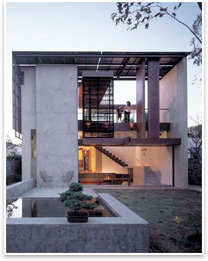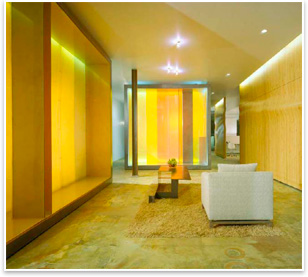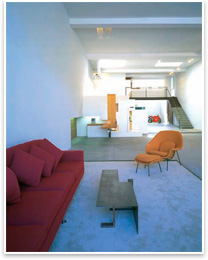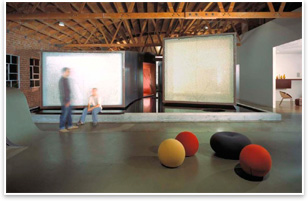| |
2010 AIA Architecture Firm Award Goes to
Pugh
+ Scarpa
Summary: The
American Institute of Architects’ Board of Directors awarded
Pugh + Scarpa the 2010 AIA Architecture Firm Award on December 3,
based on the firm’s 18 years of consistently excellent and
innovative work, including its leadership in sustainable and socially
progressive design. The firm is known for an established culture
of ingenuity and exploration that maintains a fresh approach, through
which every project is a continuation of the firm's ongoing collective
inquiry.

Solar Umbrella, Venice, Calif., entry view from
the garden. Inspired by Paul Rudolph’s Umbrella House of
1953, the Solar Umbrella provides a contemporary reinvention of
the solar canopy—a strategy that provides thermal protection
in climates with intense exposures. Passive and active solar design
strategies render the residence energy neutral.
AIA President Marvin Malecha, FAIA, notified firm principal Lawrence
Scarpa, AIA, by telephone immediately after the Board made its decision. “We’re
thrilled,” he said. “It was a surprise just to be nominated.
It’s just stunning to win.”
The AIA Architecture Firm Award, given annually, is the highest
honor the AIA bestows on an architecture firm and recognizes a practice
that consistently has produced distinguished architecture for at
least 10 years.
Founding partners Gwynne Pugh, AIA, and Lawrence Scarpa, AIA, and
Angela Brooks, AIA, who became a partner in 2001, are known for forging
a broad, inclusive, experimental approach to socially and environmentally
sensitive urban planning and design.
Marlene Imirzian, AIA, nominated Pugh + Scarpa on behalf of the
AIA Committee on Design. The submission highlighted the firm’s “ongoing
research in materials and technologies as well as constant re-examination
of known conditions, accepted norms, and established methods, which
lead to innovative solutions and stimulating new ways of approaching
design. This is true regardless of the scale—big or small,
whether for public or private use, for rich or for poor. This is
an approach that has often led [Pugh + Scarpa] to reinvent established
building and design methodologies.”
A working studio: at home with the arts
The Pugh + Scarpa office is located in Bergamot Station, a former
water-heater factory and cultural landmark the firm master planned
and converted into 46 art galleries, shops, lofts, and creative
offices. In the studio, the fusion between industrial and artistic
motifs is easily seen; the relationship between fine arts and architecture
is everywhere. Each principal is intimately involved with every
project, thus staff designers and draftspersons are directly engaged
with projects and firm principals. The firm’s modest size
and collaborative atmosphere mean that employees of every rank
and experience level can have a significant impact on the ultimate
result. The office has had employees from more than 25 countries
worldwide and makes a concerted effort to teach students with constant
internship offerings.

COoP Editorial, Santa Monica, Calif., view of
lobby from entry. This remodel of an early commercial structure
by Frank Gehry is a continuation of research into materials and
technologies. Without predefining architecture, the architects
responded directly and intuitively to the material qualities of
place, examining the tension between materials, form, and experience.
“Pugh + Scarpa’s practice is known for both design and
its commitment to running a socially and environmentally responsive
practice,” writes Thom Mayne, FAIA, in support of the nomination. “Comfortable
with aesthetic, practical, political, and functional issues, they
have mapped an architectural path that is as didactic as it is successful.”
Innovation and design process: A culture of collaboration and experimentation
Pugh + Scarpa’s design innovation is a direct product of its
process, which is the result of a carefully developed commitment
to designing without expectations or preconceived notions. The process
is exploratory and involves the client and, whenever possible, the
builder and fabricator. This dialogue creates an expeditious project
with few errors and fosters a culture of collaboration, exciting
the imagination and exceeding the expectations of both architect
and client. “Pugh + Scarpa’s work is consistently explorative
and significant to our evolving profession,” writes Tom Kundig,
FAIA, principal of 2009 Firm Award recipient Olson Sundberg Kundig
Allen. “What’s remarkable is that they bring this exploration—this
ability to push the boundaries—to projects of all scales and
types.”

Colorado Court, Santa Monica, Calif., entry view.
Unlike most conventionally developed projects, this project incorporates
energy efficient measures that exceed standard practice, optimize
building performance, and ensure reduced energy use during all
phases of construction and occupancy. The photovoltaic system delivers
electricity to the grid during the daytime and retrieves from the
grid at night as needed.
Sustainability as a catalyst for better communities
The firm has been recognized repeatedly by the AIA and other organizations
as a leader in sustainable design. For the firm, sustainability
is not a design option that can be tacked on or value-engineered
out. It is a comprehensive, intrinsic root value of design competence. “This
firm has tirelessly focused on our environment and their community,” writes
Calvin Lewis, FAIA, in support. “They have engaged innumerable
opportunities to help educate students and government officials,
as well as peer practitioners and fellow citizens. Their efforts
would be commendable if only being judged on the educational benefits
they have shared, but their most profound impact is in their actual
built work,” writes the principal of the 2001 Firm Award
recipient Herbert Lewis Kruse Blunck Architecture.
Materials investigation: making the ordinary extraordinary
Pugh + Scarpa is continuously experimenting with the built form,
researching, designing, mocking up, and testing to improvise new
ways of thinking about common materials—such as oriented
strand board—or incorporating materials that have rarely
seen application in buildings. In the early 1990s, a used shipping
container became a conference room for a film production company,
paper cups from the convenience store become luminaries, pingpong
balls are set between glass to send warm, diffuse light into private
offices. This is not mere novelty; collectively these works demonstrate
new value for ordinary items and elevate the profession’s
dialogue about materials choice to consider a far wider range of
solutions than before.

Reactor Films, Santa Monica, Calif., waiting area.
The client’s required move-in to a completed space in less
than 14 weeks from the beginning of design. To meet this demand,
design decisions were made in close association with the contractor
and various fabricators. Construction commenced the first week
of design , the city issued permits by the beginning of the second.
All drawings generated for the project served as both client presentation
and construction document.
Good design is for everyone: social justice in architecture
Pugh + Scarpa has always acted on its philosophy that good design
is for everyone, no matter what their income level. The same level
of commitment, design creativity, materials research and problem-solving
alacrity is delivered to nonprofit and affordable housing developers
and to the wealthiest clients alike. In several cases, the firm
has participated in grant writing and fundraising efforts to supply
affordable-housing agencies with energy-saving technologies. Pugh
+ Scarpa co-founded Livable Places, a nonprofit developer and policy
organization for affordable and mixed-use urban dwelling, and advanced
the dialogue on livability in California. This multi-faceted approach
has led to a wide variety of awards as well, including the Committee
on Architecture for Education Merit Award and Youg Architect awards
in 2009. As David Miller, FAIA, partner of 2003 AIA Firm Award
recipient Miller|Hull Partnership, points out, “they are
the only firm in the history of the AIA to win a national AIA Design
Award, AIA COTE Top 10 Green Building Award, and national AIA special
interest award for a single project. They have done this twice
with Colorado Court and the Solar Umbrella.”
Community contributions: shaping communities through education and
dialogue
Pugh + Scarpa’s “social and environmental commitments
go beyond individual projects to a profound belief in leadership
and participation in their own communities,” lauds Buzz Yudell,
FAIA, principal of 2006 AIA Firm Award honoree Moore Ruble Yudell.
The firm’s principals see continuity between practice, research
and writing, teaching and mentoring, and community service. In addition
to co-founding Livable Places, they have co-founded the A+D Museum
in Los Angeles; served on the Santa Monica Planning Commission and
Solar Santa Monica; and served as board members for the AIA, Woodbury
University, GSA Peer Professional, Brunner Loeb Forum, and Mayors
Institute on City Design. Firm members have presented seminars at
numerous AIA, and USGBC national conventions and countless state
and local AIA conventions; served as AIA Awards jurors over 25 times;
and taught at the university level for three decades.
A wide span of firm recognition
Over the past 10 years, the firm has won 13 national AIA awards,
including:
- Solar Umbrella, Venice, Calif., completed 2005
- COoP Editorial, Santa
Monica, Calif., completed 2003
- Colorado Court, Santa Monica, Calif.,
completed 2002
- Reactor Films, Santa Monica, Calif., completed 2000
- Orange Grove,
West Hollywood, Calif., completed 2005
- Jigsaw, Los Angeles, completed
2005

Jigsaw, Los Angeles, Floating edit studios with
ping-pong-ball walls. The film editing profession requires small,
dark environments free from distraction and light reflection—in
essence, hermetically sealed boxes. Yet, at the same time, a film
editing company, if it is to be competitive, must exist in a stimulating,
socially interactive workspace alive to workers and clients alike—a
place where people will want to be.
The firm has more than 40 state and local AIA awards. In 2008,
Pugh + Scarpa received a Lifetime Achievement Award from Interior
Design.
Other awards include; Record Houses, Record Interiors, The Rudy
Brunner Prize, Emerging Voice in Architecture presented by the Architectural
League of New York, The Collaborative Practice Award from the Association
of Collegiate Schools of Architecture, The AIA Henry Adams Medal
and The Leadership Award for Sustainable Design presented by the
California Legislature Assembly. In 2003, Pugh + Scarpa was also
selected as a finalist for the World Habitat Award presented by The
United Nations and Building & Housing Social Foundation. The
firm’s work has been featured in over 400 publications worldwide.
Some of those publications includes; Newsweek, Architectural
Graphic Standards, U.S. Department of Energy case studies, AIA
Forward, and
The Oprah Winfrey TV Show.
The award will be presented June 12 at the 2010 AIA National Convention
in Miami. Previous recipients include Olson Sundberg Kundig Allen
(2009), KieranTimberlake (2008) Murphy/Jahn (2005), and Lake/Flato
Architects (2004). |
|



